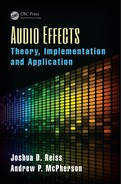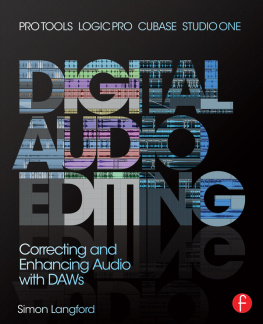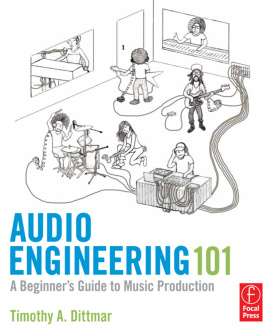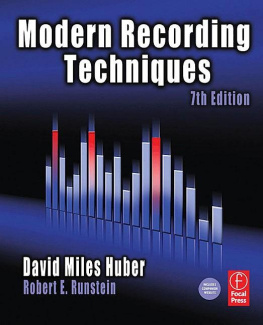
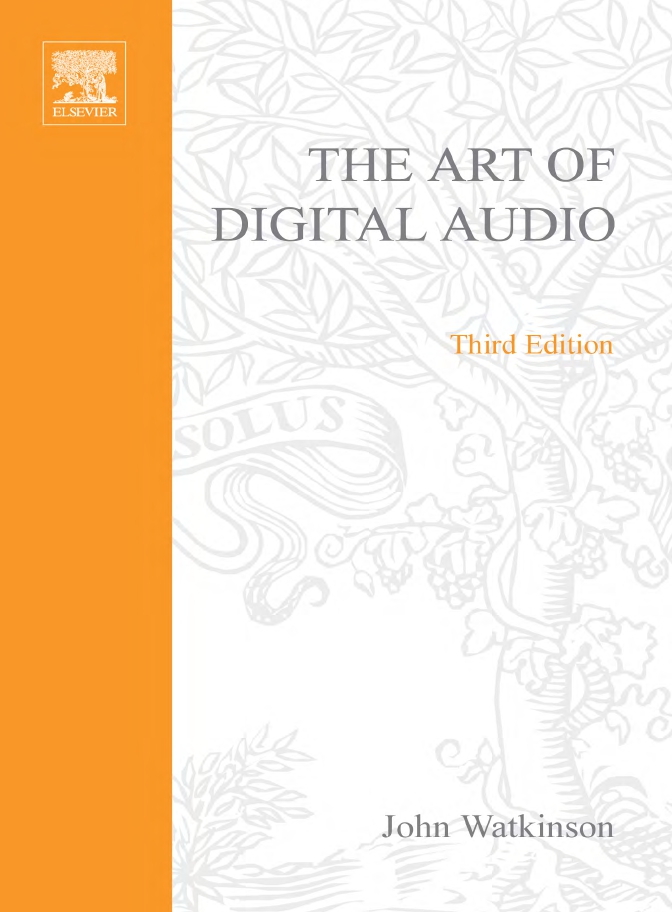
The Art of Digital Audio
For Chrissie
The Art ofDigital Audio
Third Edition
John Watkinson

Focal Press
OXFORD
AUCKLAND
BOSTON
JOHANNESBURG
MELBOURNE
NEW DELHI
Focal PressAn imprint of Butterworth-HeinemannLinacre House, Jordan Hill, Oxford OX2 8DP225 Wildwood Avenue, Woburn, MA 01801-2041A division of Reed Educational and Professional Publishing Ltd

A member of the Reed Elsevier plc group
First published 1988Reprinted 1989, 1991, 1992Second edition 1994Reprinted 1994, 1995, 1999, 2000Third edition 2001
John Watkinson 2001
All rights reserved. No part of this publication may be reproduced inany material form (including photocopying or storing in any medium byelectronic means and whether or not transiently or incidentally to someother use of this publication) without the written permission of thecopyright holder except in accordance with the provisions of the Copyright,Designs and Patents Act 1988 or under the terms of a licence issued by theCopyright Licensing Agency Ltd, 90 Tottenham Court Road, London,England W1P 0LP. Applications for the copyright holders writtenpermission to reproduce any part of this publication should be addressedto the publishers
British Library Cataloguing in Publication Data A catalogue record for this book is available from the British Library
Library of Congress Cataloguing in Publication Data A catalogue record for this book is available from the Library of Congress
ISBN 0 240 51587 0
Composition by Genesis Typesetting, Rochester, KentPrinted and bound in Great Britain

Contents
Preface
Acknowledgements
Chapter 1 Why digital?
1.11.21.31.41.51.61.71.81.91.101.111.121.131.141.151.161.171.181.191.20
IntroductionWhat is digital audio?Why binary?Why digital?Some digital audio processes outlinedThe samplerThe programmable delayTime compressionSynchronizationError correction and concealmentChannel codingCompressionHard disk recordersThe PCM adaptorAn open-reel digital recorderRotary head digital recordersDigital Compact CassetteDigital audio broadcastingAudio in PCsNetworksReference
xiii
xv
12581012131415161920212224252728293131
323336
Chapter 2 Some audio principles
2.12.22.3
The physics of soundThe speed of soundWavelength
vi
Contents
2.42.52.62.72.82.92.102.112.122.132.142.152.162.172.182.192.202.212.222.232.24
Periodic and aperiodic signalsSound and the earHearingThe cochleaMental processesLevel and loudnessFrequency discriminationCritical bandsBeatsMusic and the earThe sensation of pitchFrequency response and linearityThe sine waveRoot mean square measurementsThe deciBelAudio level meteringVectorsPhase angle and power factorAudio cablingEMCElectrical safetyReferences
36383840424547485153555861636469717274767879
8185888993939699101103103106108112115117119119120
Chapter 3 Digital principles
3.13.23.33.43.53.63.73.83.93.103.113.123.133.143.153.163.173.183.19
Pure binary codeTwos complementIntroduction to digital processingLogic elementsStorage elementsBinary addingThe computerThe processorInterruptsProgrammable timersTimebase compression and correctionGain controlDigital faders and controlsA digital mixerEffectsThe phase-locked loopMultiplexing principlesPacketsStatistical multiplexing
Contents
3.203.213.223.233.243.253.263.273.283.293.303.313.323.333.343.35
FiltersTransformsFIR and IIR filtersFIR filtersSampling rate conversionIIR FiltersThe z -transformBandpass filtersHigher-order filters: cascadingPole/zero positionsThe Fourier transformThe discrete cosine transform (DCT)The wavelet transformModulo- n arithmeticThe Galois fieldNoise and probabilityReferences
vii
121125127129136150155161167168174183186187188192194
196198202204207209211215217220224228231231233234235242249252258259264267
Chapter 4 Conversion
4.14.24.34.44.54.64.74.84.94.104.114.124.13
Introduction to conversionSampling and aliasingReconstructionFilter designChoice of sampling rateSample and holdSampling clock jitterAperture effectQuantizingQuantizing errorIntroduction to ditherRequantizing and digital ditherDither techniques4.13.1 Rectangular pdf dither4.13.2 Triangular pdf dither4.13.3 Gaussian pdf ditherBasic digital-to-analog conversionBasic analog-to-digital conversionAlternative convertorsOversamplingOversampling without noise shapingNoise shapingNoise-shaping ADCsA one-bit DAC
4.144.154.164.174.184.194.204.21
viii
Contents
4.224.23
One-bit noise-shaping ADCsOperating levels in digital audioReferences
269270272
275278279283284286287288293299301302305310312316322323324325
327329334334338344345347348350350353357360361362
Chapter 5 Compression
5.15.25.35.45.55.65.75.85.95.105.115.125.135.145.155.165.175.185.19
IntroductionLossless and perceptive codingCompression principlesCodec level calibrationQuality measurementThe limitsSome guidelinesAudio compression toolsSub-band codingTransform codingCompression formatsMPEG Audio compressionMPEG Layer IMPEG Layer IIMPEG Layer IIIMPEG-2 AACapt-XDolby AC-3ATRACReferences
Chapter 6 Digital recording and transmission principles
6.16.26.36.46.56.66.76.86.96.106.116.126.136.146.156.16
Introduction to the channelTypes of transmission channelTypes of recording mediumMagnetismMagnetic recordingAzimuth recording and rotary headsOptical disksMagneto-optical disksEqualizationData separationSlicingJitter rejectionChannel codingRecording-oriented codesTransmission-oriented codesGeneral-purpose codes
Contents
6.176.186.196.206.216.226.236.246.256.266.276.286.29
Miller codeGroup codes4/5 code of MADI2/3 codeEFM code in CDThe 8/10 group code of DATTracking signalsConvolutional RLL codesGraceful degradationRandomizingCommunications codesConvolutional randomizingSynchronizingReferences
ix
366366368369370373376376377378379383385388
390391392393394395398400402406413413415418420426428430435439
442443
445446446
Chapter 7 Error correction
7.17.27.37.47.57.67.77.87.97.107.117.127.137.147.157.167.177.187.197.20
Sensitivity of message to errorError mechanismsBasic error correctionError handlingConcealment by interpolationParityBlock and convolutional codesHamming codeHamming distanceCyclic codesPunctured codesApplications of cyclic codesBurst correctionIntroduction to the ReedSolomon codesRS calculationsCorrection by erasureInterleavingProduct codesIntroduction to error correction in DATEditing interleaved recordingsAppendix 7.1 Calculation of ReedSolomongenerator polynomialsReferences
Chapter 8 Transmission
8.18.28.3
IntroductionIntroduction to AES/EBU interfaceThe electrical interface
x
Contents
8.48.58.68.78.88.98.108.118.128.138.148.158.168.178.188.198.208.218.228.238.248.258.26
Frame structureTalkback in auxiliary dataProfessional channel statusConsumer channel statusUser bitsMADI multi-channel digital audio interfaceMADI data transmissionMADI frame structureMADI audio channel formatFibre-optic interfacingSynchronizingAsynchronous operationRoutingNetworksIntroduction to NICAM 728Audio in digital television broadcastingPackets and time stampsMPEG transport streamsClock referencesProgram Specific Information (PSI)MultiplexingIntroduction to DABDAB principlesReferences
Next page



